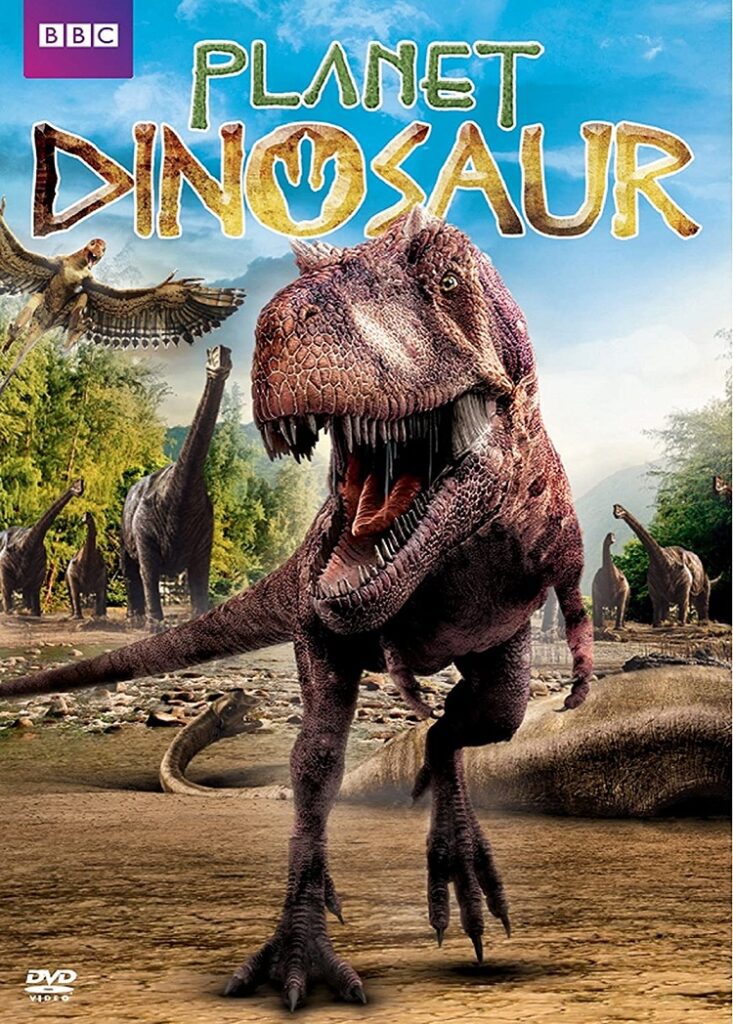
The new BBC Video release Planet Dinosaur DVD contains all six half-hour episodes of the series, which originally aired in the U.K. in 2011. The program is narrated by John Hurt, and contains some of the best CGI-created dinosaurs ever produced for television. As the introduction to each show explains, “We are living through the golden age of dinosaur discoveries. From all over the world, a whole new generation of dinosaurs is being revealed. From the biggest giants and the deadliest killers, to the weird and wonderful. From the Arctic to Africa, from South America to Asia, using the latest evidence, for the first time we have a truly global view of these incredible animals.”
I quote the introduction verbatim because it does an excellent job of describing the scope of the series. I have seen a number of excellent documentaries about dinosaurs over the years, but they usually focus on specific areas or specific prehistoric beasts. As the title implies, Planet Dinosaur takes a global view, and the “picture” of our planet from over 150 million years ago is a fascinating one indeed.
The series begins with “Lost World,” which takes us to Northern Africa some 95 million years ago. The “star” of this installment is the giant Spinosaurus, which is considered the largest of all known dinosaurs, even bigger than Tyrannosaurus and Giganotosaurus. The name “Spinosaurus” literally means “spine lizard.” Besides its size, the significance of the discovery is that Spinosaurus looks to be a direct link to the modern crocodile, living on both land and sea, and primarily feeding on fish.
“Feathered Dragons” goes back much further than “Lost World“ did, beginning 154 million years ago to show us ancestors of modern birds. These spans of time are just mind-boggling to me, and the CGI work of creating the animals, and their environments is fantastic. In the opening scene, a Epidexipteryx escapes from a juvenile Sinraptor by climbing a tree. As is the case of each of the programs, a story then unfolds which introduces us to the various hunters and prey of the era.
By the time I reached “Last Killers,” I was completely hooked. This one goes back “only” 70 million years, to discuss the final era of such giants as Daspletosaurus and Majungasaurus. We see them laying in wait for the annual migration of Centrosaurus. As it turns out though, the majority of the Centrosaurus wound up drowning, rather than being eaten. With massive global changes upon them, these are the last days of dinosaurs such as Daspletosaurus and Majungasaurus, as well as the other “killer dinosaurs” of the time.
Planet Dinosaur is not presented in chronological order, so in the fourth program we visit Earth 150 million years ago. “Fight for Life” is a fairly self-descriptive title for the episode, which takes place in Europe. Most of the action revolves around water based creatures, such as the unusually named “Predator X.” Predator X is a newly discovered species of the pliosaur family, but very little is known about it as yet. However, from what has been discovered, scientists now consider it the “most fearsome animal ever to swim in the oceans.”
“New Giants” takes place in both South America and North Africa, 95 million years ago. Of all of the individual programs comprising Planet Dinosaur, this one tells the most “coherent” tale. We begin at the nest of a Argentinosaurus, which is being attacked by a Chaoyangopterid Pterosaur, which is in turn attacked by a Skorpiovenator. This cycle continues throughout the program, introducing us to many other literal “new giants.”
The sixth and final installment is “The Great Survivors.” The hunter and prey situation is again the dominant feature, and we go back as far as 92 million years, this time in North America. The episode eventually moves forward to 65 million years ago, when an enormous asteroid crashed into the Gulf of Mexico. The devastation of this event caused the extinction of what is estimated to be 60% of the planet’s species.
The bonus feature on Planet Dinosaur is “How to Build a Dinosaur.” Hosted by anatomist Alice Roberts, this impressive hour-long piece walks us through the process of how scientists actually “build” the various dinosaurs. With each new discovery, many previously held ideas are questioned, and it is an ongoing process. Much more will undoubtedly be revealed as time and technology move forward, and will continue to change their (and our) knowledge of the animals.
It is a marvel to see these scientists at work. For example, I have always wondered just how is it that we know what color a particular species was. The skin pigmentations themselves have not survived in fossil form over the course of hundreds of millions of years have they? Unbelievably, as it turns out, some actually have. This and many other intriguing facts emerge over the course of “How to Build a Dinosaur,” and it – like Planet Dinosaur itself, is highly recommended.